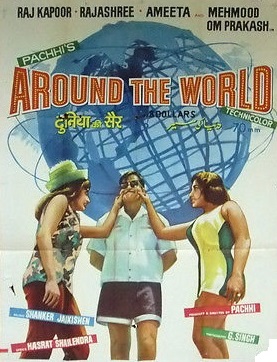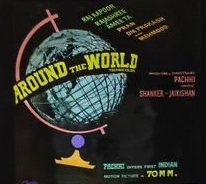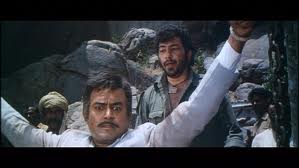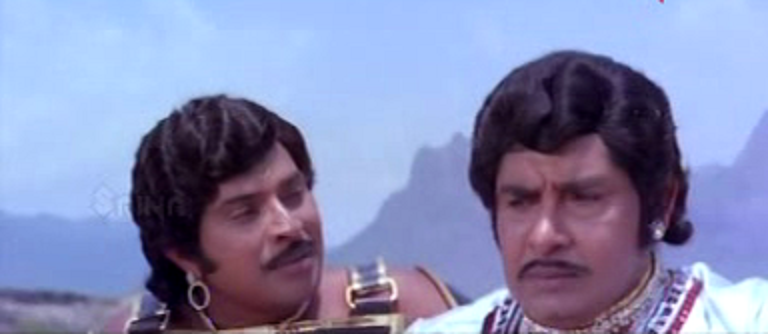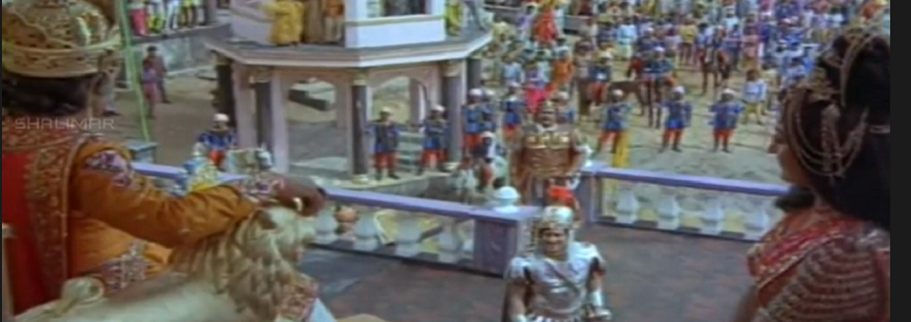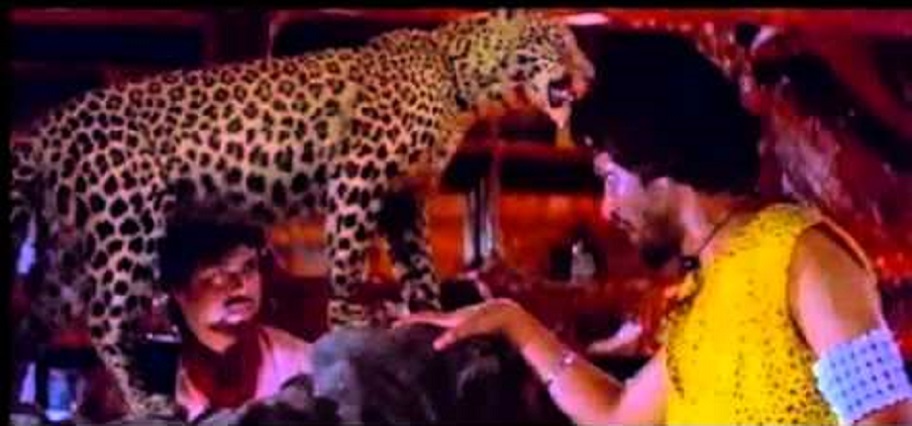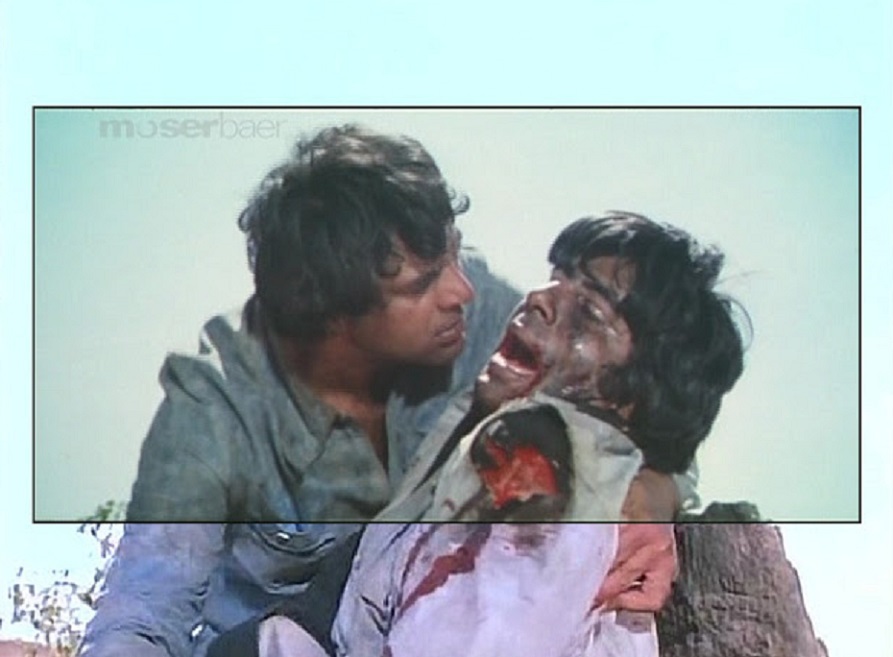70mm films in India/ South Asia
Expensive 70mm film is quite different from CinemaScope (which uses 35mm film), though both are projected on the same big screen. Most modern IMAX films use 70mm film. Almost all other Indian--indeed, South Asian--feature films are in the cheaper CinemaScope.
The Indpaedia page IMAX in India has illustrated details on the differences between 35mm, 70mm, and Imax
See CinemaScope films in Bangladesh, India, Nepal, Pakistan, Sri Lanka
You can update or correct this page, send photographs and/ or |
Contents
|
70mm
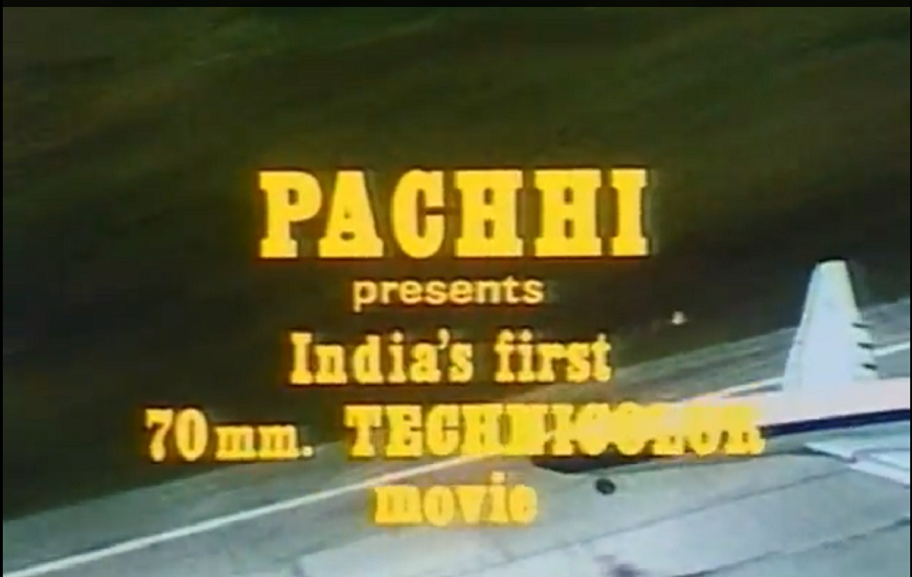
(Above is a freeze-frame from ATW and has been painstakingly culled from the film itself to settle the issue of India's first 70mm film once and for all.)
'Pachhi presents India's first 70mm. Technicolor movie.'
This scene was an exciting moment for cinema-technology lovers in India. Not only had India become the fourth country to make a 70mm film independently (and the ninth if we count co-productions) but also because 'Around the World' had outdoor photography of a kind that was new to India. Photographing a real aeroplane and the runway below it from above was something Indian cinema photographers had never done before, nor had they ever shot an aeroplane's wheels touching down. The ski chase, too, had no precedent in India.
A 35mm print of the whole film can be seen on YouTube. The frame seen above occurs just before the credit titles.
The makers of Sholay have never claimed that theirs was the first Indian 70mm film. This is a greatness thrust upon Sholay by misguided and uniformed fans. Similarly, Guru Dutt never said that Kaagaz ke Phool was India’s first CinemaScope film, though some fans insist that it was so.

India
Readers might want to begin by reading the section The difference between 35mm (normal); 35mm CinemaScope and 70mm close to the bottom of this article.
70mm cinemas screen Anglo-American films
New Delhi’s Shiela (the spelling is correct), which was inaugurated on January 12, 1961, was India’s first cinema hall capable of screening 70mm films. Solomon and Sheba (1959; in Delhi in 1961) was the first film it screened in 70mm.
My Fair Lady (1964; in Delhi in 1965) was a success among elite audiences--the stereophonic sound effects of its horse racing sequence had the public asking for more stereophonic sound systems in India. Though India’s audiences for English-language cinema formed a much smaller percentage of the nation’s population in 1961 than they do in the 21st century, their numbers were sufficient to ensure that several ‘70mm halls’ were constructed in each of India’s six major metropolises in the 1960s, and at least one in every medium-sized state capital.
As early as in 1964 actress B. Saroja Devi and entrepreneur V. Ramasamy Naidu set up Central 70mm in a town as small as prosperous Coimbatore. Despite its tickets being almost twice as expensive as those of the next priciest hall, Central, which was air conditioned and housed one of India’s first ‘ice-cream-soda fountains,’ was a commercial success.
Cleopatra (70mm/ UK | USA | Switzerland) was the highest grossing film of 1963 internationally. In India it was a hit even with those who did not normally watch foreign films. Bangalore's Lido (c 1965), which was the first in Karnataka to show 70mm films, inaugurated the 70 mm vogue in Karnataka with a screening of Cleopatra
By 1964 there was a sufficiently large number of halls with 70mm projectors and widescreens in India. Therefore, several Indian producers started launching ‘70mm films.’ This really meant that around four prints would be in 70mm, and the rest in 35mm. In any case, only a few prints of even Hollywood blockbusters were in 70mm, though the percentage was somewhat higher there.
India's first 70mm film
70mm films announced before 'ATW'
Among the earliest ‘70mm’ films to be launched (or at least announced, with huge fanfare) around 1965 and 1966 were Alexander and Chanakya (an Indo-German co-production), Kaar Begaar (with megastar Dilip Kumar), Gold Medal (with the by then highest paid star Rajendra Kumar; it was completed in 35mm with Jeetendra) and International Crook (released only in 35mm, because of the lukewarm commercial response to the same producer’s 'Around the World'). Alexander and Chanakya was abandoned. However, for decades Dilip Kumar nursed the dream to make Kaar Begaar, which was about corvee labour.
The first Indian 70mm film to be released
Pachhi’s 'Around the World' (1967/ Technicolor) was the first Indian film to be actually released in the 70mm widescreen format, and also the first with a magnetic, six-track stereophonic soundtrack. It is frequently, and incorrectly, said that ‘Sholay’ (1975) was India’s first 70mm film, and the first with stereophonic sound. In this connection an inaccurate NDTV documentary is cited.<ref>"35 years on, the Sholay fire still burns". ndtv.com. Retrieved 6 December 2010.</ref> It was the second, on both counts.
India's second 70mm film is an all-time grosser
'Sholay' was the biggest grosser of its era and, by some yardsticks,the most successful Indian film ever. Its success made producers with somewhat smaller budgets think of the vastly less expensive CinemaScope instead. Besides, almost all Indian theatres, including in the smallest of towns, had CinemaScope facilities by the late 1970s; only a few hundred were equipped for 70mm.
In the case of both 'Around the World' and 'Sholay' exactly four 70mm prints were released in the first instance: two were allotted to the Bombay-Maharashtra territory, and one each to Delhi and U.P. And yet both films were screened in 70mm at two cinema halls in Delhi ('ATW' at Amba and Liberty and 'Sholay' at Plaza and Liberty). This was achieved by shuttling the 70mm print allotted to Delhi between the two halls. Over the decades 'Sholay' has acquired such a dedicated fan following that fans insist that it was India's first film in 70mm and six-track stereophonic sound, even though the film's makers have never made any such claim. All surviving prints (and DVD released by Shemaroo) of 'ATW,' on the other hand, do.
The first 70mm films of other countries
India was the world’s fourth country (after the USA, USSR and West Germany) to have independently produced a 70mm film. If we count co-productions, it was the ninth country. The first 70mm feature film of each country/ group of countries to have released a 70mm feature film before India was:
USA: Oklahoma! (1955)
USSR: Povesti Plamennikh Let/Chronicle of Flaming Years (1961)
West Germany (FRG): Flying Clipper – Traumreise unter weissen Segeln (1962)
France/Spain/Italy: Shéhérazade (1963)
West Germany/Yugoslavia/France/Italy: Old Shatterhand (1964)
West Germany/Austria: Der Kongress amüsiert sich/Congres of Love (1966)
Loss of image when 35mm (normal) is blown up to 70mm or CinemaScope
Since actual 70mm (or 65mm) cameras and film were deemed too expensive at the time, both 'Around the World' and ‘Sholay’ were shot on traditional 35mm film and the 4:3 picture was subsequently blown up, cropped and matted to a 2.20:1 frame. (See picture below)
All Indian ‘70mm films’ after 'Around the World' and ‘Sholay’ were photographed in the 35mm CinemaScope format and blown up to 70mm. This means that the 35mm prints of both 'Around the World' and ‘Sholay’ have images at the top and bottom of the frame (and, thus, of the screen) that cannot be seen in the 70mm print, because those strips have been cropped off. However, because "Padayottam,"‘The Burning Train,’ ‘Shaan’ and subsequent ‘70mm films’ were shot in CinemaScope, which has almost the same ‘aspect ratio,’ there was negligible loss of image.
(V. Shantaram's superhit color by Technicolor classical-dance [kathak] opus Jhanak Jhanak Payal Baaje (1955)was re-released in 70 mm in 1982. However, by then audiences had no appetite for 143 minutes of kathak, androgynous and anonymous actors in major roles and Sanskritised dialogues. Unlike Mughal e Azam (1960), which was given a fresh lease of commercial life in 2004 by the addition of colour, CinemaScope and Dolby sound, Jhanak Jhanak Payal Baaje could not be resurrected by 70 mm. The point is that, like 'Around the World' and ‘Sholay,’ the 35mm frames of Jhanak Jhanak Payal Baaje had to be cropped.
(The Amitabh Bachchan-starrer 'Mr. Natwarlal' was shot in normal 35mm, but by 1979, when it was released, the widescreen craze had become so pronounced that the film was reformatted and released in CinemaScope. Mughal e Azam is the other major film to be reformatted from normal 35mm to CinemaScope.)
Film historian Chamunda Binay Kumar Pandey has graphically shown how extra images (‘information’) along the four sides of the original 35mm version had to be lopped off to achieve the widescreen ratio of 70mm. Two 70mm images from Sholay, framed by Chamunda within the 35mm original, can be seen on this page. (From Chamunda’s article ‘Sholay - Special Edition DVD of Alternate Version.’[1])


As this Delhi advertisement indicates, both Amba and Liberty were ‘renovated for 70mm’ for ATW. Why were these theatres subjected to this additional expenditure when Delhi’s Shiela and Odeon already had 70mm facilities? Because Shiela and Odeon mainly catered to English- speaking audiences. Liberty is in West Delhi, where affluent Punjabis live (and was later chosen to screen Delhi’s sole 70mm print of Sholay for the same reason) and Amba in Hindi-speaking North Delhi.

Please note that Amba’s show timings are quite different from the ones indicated for the other theatres in the advertisement above. This was to provide for the time that it took to shuttle ATW’s sole 70mm print allotted to Delhi between Liberty and Amba.
Both advertisements were published in The Hindustan Times, Delhi, in the second half of August 1967.
After the success of Pakeezah there was enormous demand, at least among educated audiences, for CinemaScope. By 1972 most theatres even in B and C towns had installed widescreens meant for CinemaScope. In those days the men who controlled Hindi-Urdu cinema were slow to adapt to new technology. So, India had a situation in which there were widescreens everywhere but no Hindi-Urdu CinemaScope films to project on them.
In Delhi the managements of first Chanakya and then Kamal (both theatres are now defunct) decided to take things into their own hands. They purchased powerful projector-lenses and started blowing up normal (3:4) 35mm prints of films like Jawani Diwani and Bawarchi respectively (both 1972) onto the 1:2.35 screen--lopping off the top and bottom (but not the right or left), somewhat like the makers of 'Around the World,' ‘Sholay’ and 'Jhanak Jhanak Payal Baaje' have done officially.
The 70mm trend catches on
By the 1970s, the trend in Hyderabad was to build two-screen bi-plexes—with one ‘35mm theatre’ (with CinemaScope facilities) for Telugu and Hindi-Urdu films, and one ‘70mm theatre’ for English language films, both within the same building.
The unprecedented nationwide success of Sholay started the trend of releasing a few prints of many blockbusters in the major Indian languages in 70mm. Because the number of films to be blown up to 70mm had reached the critical level, it did not make sense to continue to send prints to the UK or USA for processing in 70mm. MIS Prasad Film Laboratories, Chennai and Ramnord Research Laboratory were the first to process 70mm (65mm) films within India, though the resultant colours were normally not as appealing as those processed in the West. Prasad set up a ‘70MM Recording Division’ (for stereophonic sound).
Karma (1986), was arguably the last major 70mm hit in Hindi-Urdu. Shoddy, processed-in-India 70mm films did nothing to enhance their appeal either. Soon B films were being made in 70mm, and the format had lost favour internationally.
By the 1990s the grain and resolution of CinemaScope films reached the level of the 70mm films of yore. Therefore, the 70mm trend gradually faded away from Hindi-Urdu films, though it lingered on for a few years more in India's less populous linguistic regions, which had also been late to take to the trend of making ‘70mm films.’
An Indian 70mm camera
In 1991 T. V. Somasundaram, a cinematographer, pioneered a light weight sixty five mm (i.e. 70mm) movie camera, much lighter than its international counterparts. It had a variable and constant motor in one, flexible eyepiece tube, and could be mounted on a Steadicam. He tested the camera with raw stock purchased in the UK and exposed through the Carl Zeiss lens of a Hasselblad still camera. The results were fairly good in terms of colour and sharpness, edge to edge. There was no formation of grains. [2] However, by then the 70mm era was almost over.
A list of Indian films in 70mm
"Around the world"(Hindi-Urdu)1967 Above average commercial success; the no.11 Hindi-Urdu earner of the year, but despite hit songs was not the superhit that its big budget demanded.
"Sholay"(Hindi-Urdu)1975 By some calculations the biggest grosser in Indian history.
"Padayottam" (the first Malayalam film in 70mm)1980. It was screened in 70mm only in Trivandrum, Ernakulam, Trichur and Calicut.
“The Burning Train” (1980) (Hindi-Urdu)Flop
Shaan (Hindi-Urdu)1980 A weak success. Not the superhit that its big budget demanded.
"Badle Ki Aag" (Hindi-Urdu)1982 Above average. The no.15 grosser of the year.
"Razia Sultana" (Hindi-Urdu)Flop
"Mahaan" (Hindi-Urdu)1983. Made money because Mr Bachchan acted in it, but not a hit by his standards. No. 10 that year.
‘Swapna Sagar’ (the first Odiya film in 70mm)(1983)
"Saagar"(Hindi-Urdu)Above average. No. 11 in the commercial rankings of 1985.
"Karma" (Hindi-Urdu)1986 The no.2 hit of the year
"Simhasanam" (1986/ Telugu, d: Krishna) (the first Telugu film in 70mm)
"Dayavan" (Hindi-Urdu)1987 Above average. The no.7 grosser of the year.
"Sharavegada Saradara (1989) (the first Kannada film in 70mm )
"Maa Veeran" (1986/ Tamil; d: Rajasekar(the first Tamil film in 70mm)
"Thandara Pappa Rayudu" (Telugu)
"Samraat" (Telugu)
Ram Gopal Varma's "Raat" (Hindi-Urdu/ 1992)was a 'B film' Commercially speaking, the no.39 film of the year. Way below average success--the film sank and took 70mm down with itself. Was perhaps the last 70mm film in Hindi-Urdu.
Main source of 70mm films: in70mm
All commercial rankings given in this article are from ibosnetwork.com
Other 70mm films
The above list was cross-checked from as many sources as possible and is arguably a complete list of all 70mm films ever made in India.
It has been confirmed that only one Malayalam film, "Padayottam", was released in 70mm.
Despite several Google searches the name of no 70mm film in Bengali or Marathi, and no other 70mm film in Kannada, Malayalam, Oriya or Telugu (apart from the list above) was found.
The writer of this article distinctly remembers one of the makers of the war film Muthina Haara (Kannada/ 1990, dir S.V. Rajendra Singh Babu) telling him about Muthina Haara or its successor Kannada film being in70mm. However, it has not been possible to verify this.
About Tamil cinema, a wikipedia article says, “ Vetri Vizha (1989/ Tamil; d: Pratap Pothan) is the first of two Tamil films made in 70mm format; the other was Amaran (1992/ Tamil: dir K. Rajeswar).” (Vetri Vizha, incidentally, was one of the most successful Tamil films of its time.)
Mr Pratap Pothen himself set the controversy about Vetri Vizha at rest on மாயவரத்தான் by writing. ‘No it was not in 70mm’
So, there.
மாவீரன் (Maa Veeran) was indeed the first 70mm film in Tamil.
Two sources, obviously citing each other, claim that ThaiMaman (1994/ Tamil) was released in 70mm. tamilkey
But from most accounts Maa Veeran (1986) was the only Tamil film in 70mm
Was Ek Duuje ke Liye in 70mm, as a site claims it was? The film's censor certificate says '35mm' but that does not mean that some prints could not have been made in 70mm. It only means that the print given to the censors was in 35mm. However, nothing in the film's credit titles indicates 70mm either--not even a refernce to the laboratories at which the film was processed. Therefore, we have not included it in the 70mm list.
Pakistan: theatres
South Asian countries other than India did not produce70mm films. Bambino cinema, Karachi, inaugurated by then president Ayub Khan in 1968, was home to the first 70mm projection screen in Pakistan. On September 21 2012, protesters denouncing an anti-Islam film set on fire the Bambino, Capri, Gulistan Talkies, Nigar, Nishaat and Prince cinemas, while in Peshawar, they stormed the Capital, Naz, Shabistan and Shama cinemas. The Karachi cinemas were destroyed; the ones in Peshawar damaged.
The difference between 35mm (normal); 35mm CinemaScope and 70mm
Oklahoma! (1955/ USA) was the world’s first feature film in 70mm; Povesti Plamennikh Let/ Chronicle of Flaming Years (1961/ USSR) the first made in the socialist bloc; and Flying Clipper – Traumreise unter weissen Segeln (1962/ West Germany) the first made in Western Europe.
70mm and 35mm indicate the width of the film—and not of the screen on which the image is projected. The ratio of height: width (i.e. the ‘aspect ratio’) of 70mm film is 1:2.20. The screen should be in at least the same ratio. 70mm films require special projectors, special cameras and a film that is twice as wide as 35mm.
‘Normal’ (non-anamorphic) 35mm films (e.g. Pather Panchali, Sangam, Kadalikka Neramillai, Pyaasa and the original Mughal-e-Azam) have an ‘aspect ratio’ of roughly 3:4 (actually, 1:1.37). That is also the ratio of the screens they need for projection.
CinemaScope, on the other hand, is the name of a process (and of a lens). CinemaScope movies are shot on standard 35mm film. However, the image that emerges from a ‘CinemaScope projector’ (i.e. a normal 35mm projector with an anamorphic lens) has an ‘aspect ratio’ of 1:2.35. The CinemaScope screen, thus, must have the same ratio, too.
In other words, CinemaScope uses not only normal 35mm film but the same projector, too. During the shooting, an anamorphic lens—i.e. a 'CinemaScope lens'—shoots a wide image but compresses it horizontally on 35mm film, the aspect ratio of which is almost half as wide.
A screen meant for CinemaScope films has to be wider than one for 70mm films--if the height is the same. Therefore, when a 70mm film is projected on a ‘CinemaScope screen,’ vertical strips of white space are left blank on the left and right of the 70mm image.
Now, the small 35mm film contains a slightly bigger image than the twice-as-wide 70mm. This is because 35mm normal has an aspect ration of 1:1.37 or almost 3:4. But when the image on the 35mm film is widened through an anamorphic lens onto a 1:2.35 'CinemaScope' screen, obviously the image will not be as sharp as an image projected from 70mm on the same screen (or on a 1:2.20 '70mm' screen, on which it will be sharper still). That is why filmmakers with big-budgets preferred 70mm.
However, with dramatic improvements in lenses, by the 1990s CinemaScope films started looking as crisp as the 70mm films of yore. Besides, they were cheaper to shoot, to make copies of and to project. Therefore, 70mm slowly faded away from India—and elsewhere. In the USA two 70mm feature films have been made since 1997 (Samsara (2011) and The Master (2012)); in Europe one 70mm feature after 1994 (As Wonderland Goes By (Australia/Bulgaria 2012)); and in Russia none after 1994. wikipedia (This list does not include films short partially in 70mm and short films.)
(The width of 70mm film is exactly that--70mm. However, the image is only 65mm wide. The remaining 5mm contain the sound--6 track stereophonic sound or better. By the early 1980s even Indian films in 35mm CinemaScope had stereophonic sound, and by the early 1990s DTS and Dolby sound. So, even that justification for 70mm disappeared.)
Acknowledgments
vijay <vijaymadurai@gmail.com>
See also
CinemaScope films in Bangladesh, India, Nepal, Pakistan, Sri Lanka
70mm films in India/ South Asia
